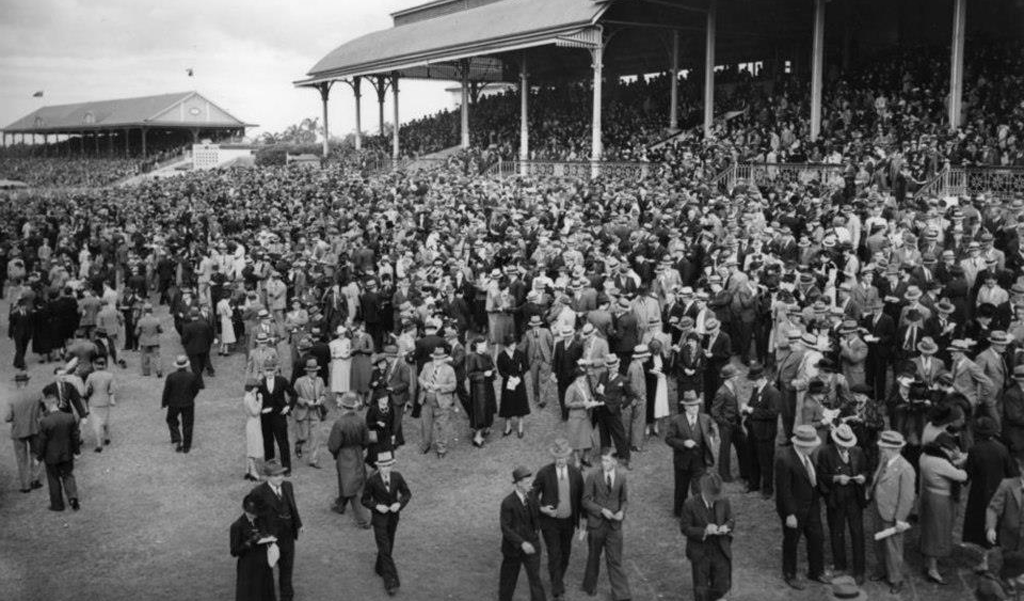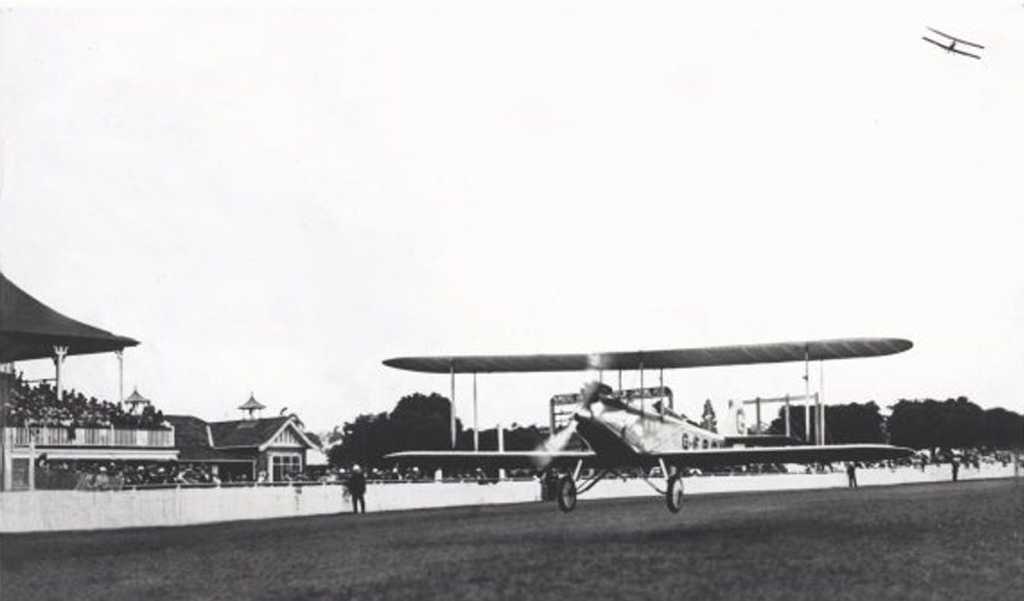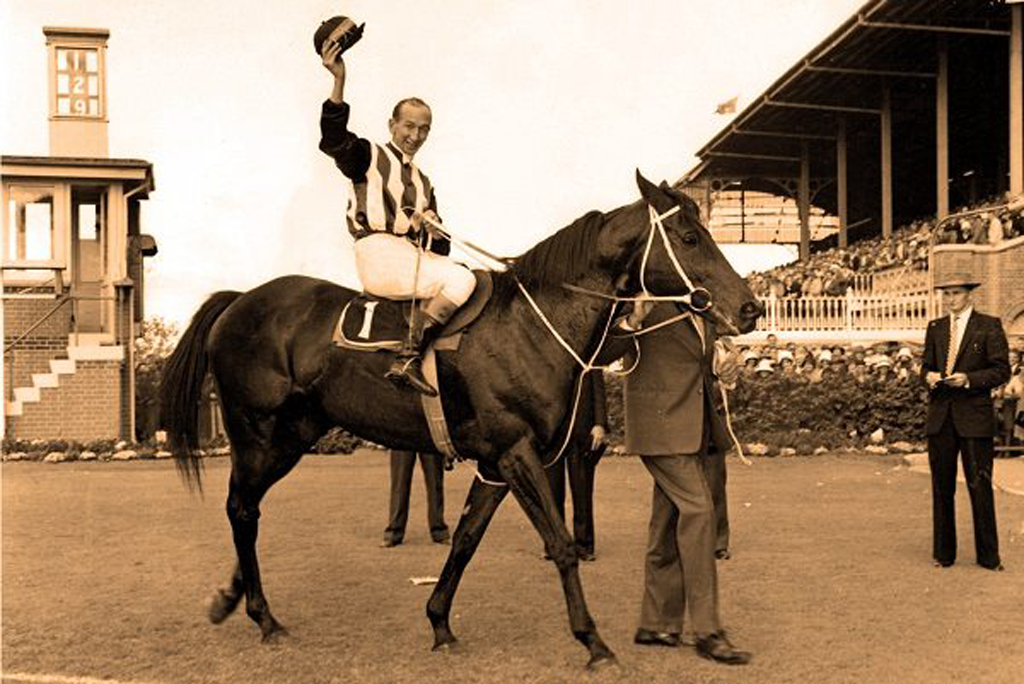Highlights of Moments in Queensland Racing History!Written on the 31 October 2016
1800's The Flat (infield) at Eagle Farm was used as a venue for the first England v Queensland cricket match. 1883 First Queensland v NSW rugby match Mid 1880's Track established "by the creek" - Albion Park - with a sand surface. It was purchased by Melbourne businessman, John Wren in 1910 and unregistered race meetings were conducted. In 1924 the Brisbane Amateur Turf Club was formed and purchased Albion Park from Mr Wren for 300,000 pounds ($600,000). 1893 Flood severely damaged Eagle Farm and the QTC was rendered penniless, with commitee members personally injecting cash to keep the club afloat. 1927 The Duke and Duchess of York attended an Eagle Farm race meeting.
Bundaberg born aviator, Bert Hinkler, landed his plane on the home straight of Eagle Farm, after his record-breaking solo flight from Britain to Australia. 1932 The first broadcast of racing on radio station 4BC was made. The caller was J C Anderson who remained in the role until 1947. 1933 The BATC opened Doomben Racecourse, QTC Apprentice School Launched.
1934 Race broadcasts for the first time over the on course public address system. 1938 Fred Shean became the first Queensland Jockey to win a Melbourne Cup on Catalogue. 1941 Deagon Racecourse closed. 1942 Doomben "straight six" course closed with land resumed to become part of the Brisbane Airport.
Eagle Farm and Doomben tracks were closed down for occupation of American servicemen. Brisbane racing was held only at Albion Park. 1944 The George Anderson-trained Tea Rose became the first Queensland filly to win the AJC Derby. 1946 The Victory Cup meeting at Eagle Farm attracted 50,000 patrons and there were 350 bookmakers operating across the three enclosures. Also in 1946, the winter carnival gained national spotlights with the running of the first Ahern Memorial win by the champion Bernborough under 10st 5lbs (66.5kg). He broke down later that year in the Mackinnon Stakes. 1948 Photo finish camera introduced. 1950 After race swabbing introduced. 1952 Betting boards for bookmakers introduced. Prior to this, service bookies simply called the odds out to punters. 1958 John Power Stand opened at Eagle Farm, QTC and BATC offices transferred from Petrie Bight in the Brisbane CBD to Eagle Farm and Doomben respectively. 1959 Stewards' films introduced. Macdougal becomes the first Queensland-owned horse to win the Melbourne Cup.
A packed Eagle Farm with a crowd in excess of 30,000 cheered wildly as champion Tulloch made a triumphant farewell to racing in the Brisbane Cup under 9 stone 12 pounds (62.5kg). 1965 The Southport Jockey Club and Oxenford Race Club amalgamate to form the Gold Coast Turf Club. 1968 Night harness meetings launched at Albion Park. The Flat enclosures at Eagle Farm and Doomben closed. 1969 - 1975 A Corinthian Handicap for amateur riders was held at Eagle Farm. 1970 Midweek racing re-introduced at Albion Park. 1971 TAB record dividend of $99,612.45 for a treble of Buck's Lady, Gallant Duke and Black Wolf at Eagle Farm. 1972 Racing switches to metric measures. The QTC holds a trial meeting on the sand track at Eagle Farm. The first Inter-Dominion Pacing Championships held at Albion Park and won by Welcome Advice. The Gabba Greyhound Club is formed. 1974 The Prime Minster's Cup is introduced at the Gold Coast. 1976 Closed circuit direct telecasts of interstate races commences on course. 1977 Mick Dittman rode seven winners and a second at Eagle Farm. His only defeat came on the 7-2 favourite Strong James. 1979 Computerised tote introduced to metropolitan tracks. Also in 1979, Pam O'Neill is the first female to be licensed as a jockey to compete on equal status as the males. She rides a treble at her first unrestricted meeting at the Gold Coast on May 19th. 1980 Racing is separated from State Treasury and allocated an independent portfolio under Russ Hinze. 1981 Albion Park sold to the State Government and closed as a galloping venue after more than 100 years. 1982 The new $8 million grandstand at Doomben is opened. 1983 On course tote turnover topped $1 million for the first time on Elders Stradbroke Day on June 11. 1984 Jockeys joined the AWU on strike action on Rothmans 10,000 Day (Doomben 10,000) over a pay dispute with on course staff. The race was transferred to the midweek and won by Getting Closer. Bold Personality is substituted for Fine Cotton at Eagle Farm on August 18. Eight men and one woman are warned off racecourses by the AJC over the Fine Cotton ring-in. 1985 The caffeine crisis rocks racing in Queensland. Over 100 positive swabs later found to have been caused by testing sticks used in the QTC laboratory containing caffeine. Trainer Hayden Haitana and company director Robert North jailed for 12 months on conspiracy charges over the Fine Cotton affair. Also in 1985, women granted the right to full membership of the Queensland Turf Club. 1986 The Fine Cotton ring-in mastermind John Patrick Gillespie jailed for four years. Also in 1986, the initial Magic Millions yearling sale was held at the Gold Coast. A $1 million race associated with graduates of that sale was run on the Gold Coast a year later and won by Snippets. The Sunshine Coast Turf Club opens the Corbould Park Racecourse in July. 1987 National satellite TV service Sky Channel commences live telecast of racing. 1990's New Zealander Rough Habit made five trips to the Queensland Winter Racing Carnival and landed two Stradbrokes, three Doomben Cups, the Queensland Derby, two Hollindale Stakes and the P J O'Shea Stakes. 1991 The State Government proposed legislation to strip all Principal (race) Clubs of power and a new central Principal Club be installed with representatives from four regional associations and industry participants. 1997 The annual general meeting of the QTC recorded a unanimous vote for incorporation to allow the club to have freehold title of the Eagle Farm Racecourse in its own name from March 31, 1998. 1999 Queensland TAB privatised. 2007 Equine influenza swept through NSW and South-East Queensland. Racing in SE Queensland was shut down for three months. 2009 The Brisbane Racing Club was formed through an amalgamation of the Queensland Turf Club and the Brisbane Turf Club. 2011 (May 14) Black Caviar makes her only race appearance in Queensland, winning the BTC Cup at Doomben in win number 13 of a record which ends with retirement after an unbeaten 25 starts. She comfortably defeated two proven Group 1 performers in Hay List and Buffering. 2014 (August 20) Racing at Eagle Farm is suspended indefinitely for a total reconstruction of the course proper. Early 2015 All training tracks at Eagle Farm are closed and training is conducted at Doomben recessitating over 400 horses based at Eagle Farm to be transported across Nudgee Rd pre-dawn six mornings a week. 2015 The BRC's four winter carnival race dates including the flagship race the Stradbroke Handicap are run at Doomben for the first time due to the closure of Eagle Farm for reconstruction. 2016 (June 4) The planned return to racing at Eagle Farm for the Queensland Oaks meeting is cancelled due to torrential rain. The first meeting on the new track is held the following week with a ten event card on Stradbroke Day. (Pictures courtesy of racecourserd.com.au)
|

 Calling all history buffs. If you missed it, Bart Sinclair of Brisbane Racing Club News included a timeline of some significant moments in Queensland Racing. Below is a reproduction of the timeline of events for your interest. I was particularly surprised to find the Eagle Farm and Doomben Racetracks closed down during WW11 to occupy American servicemen.
Calling all history buffs. If you missed it, Bart Sinclair of Brisbane Racing Club News included a timeline of some significant moments in Queensland Racing. Below is a reproduction of the timeline of events for your interest. I was particularly surprised to find the Eagle Farm and Doomben Racetracks closed down during WW11 to occupy American servicemen. 1928
1928 1942-1945
1942-1945 1961
1961


